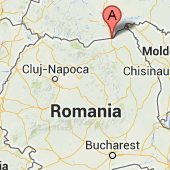Historical Background
 Siret is a town in northeastern Romania, in the current county of Suceava. As early as the seventeenth century, Jews had settled in Siret (Ger., Sereth), a medieval Moldavian town that had been the former capital of the principality. When Bucovina was occupied by Austrian troops in 1774, eight Jewish families (with 43 people) were recorded as living there.
Siret is a town in northeastern Romania, in the current county of Suceava. As early as the seventeenth century, Jews had settled in Siret (Ger., Sereth), a medieval Moldavian town that had been the former capital of the principality. When Bucovina was occupied by Austrian troops in 1774, eight Jewish families (with 43 people) were recorded as living there.
To limit emigration from Galicia, imperial authorities ordered the expulsion of 18 Jewish families (61 members) from Siret in 1782. The remaining Jewish inhabitants were compelled to give up their traditional professions and to take up farming. Nevertheless, the Jewish population continued to grow over the following decades; in 1807 there were 65 Jewish families, and in 1880 there were 3,122 Jews out of a total of 7,240 inhabitants. On the eve of World War I, the number of Jews in town had reached about 3,500.
Jewish shops, workshops, and inns made up the urban core of the town: the first multistoried building in stone was erected by a Jew at the beginning of the nineteenth century. Although the Jewish community had originally been a branch of that of Suceava, the community of Siret acquired its autonomy shortly after 1850, when it already had one synagogue and eight prayer houses. The local Jewish bourgeoisie tended to favor the German language and culture. Large numbers of Jewish children attended not only German elementary schools but also the science high school, founded in 1875, where they accounted for 52 percent of all students. Others attended the German high school, opened at the beginning of the twentieth century, where in 1905 approximately 55 percent of all students were Jewish. Most of the town’s leaders, civil and communal servants, physicians, teachers, lawyers, pharmacists, industrial entrepreneurs, bankers, and tradesmen were Jewish. In 1912, a Jew was elected mayor of the town.
After 1918, when Bucovina was annexed to Romania, the Jewish community felt pressure to “Romanianize.” This compulsion stimulated initiatives favoring intracommunity solidarity—through humanitarian or philanthropic associations and foundations, on the one hand, and, on the other hand, through support for Zionism and the social democratic left wing. Antisemitic agitation of the Romanian extreme right factions in the 1930s generated a climate that, following the retreat of the Romanian army from northern Bucovina in June 1940, led to the first bloody acts of violence against the Jewish population.
One year later, after war was declared against the USSR, all Jewish inhabitants of Siret (in 1930 there were 2,121 out of a total of 9,905, whereas in 1941 only 1,614 remained) were evacuated as potential subversives to camps in southern Romania: first to Dorneşti and eventually, after a 14-day journey in cattle cars, to Craiova and Calafat. In October 1941, they were transferred to Rădăuți, and then to camps and ghettos in Transnistria; more than 700 people died during a journey marked by massacres, starvation, and diseases.
Upon their repatriation to Romania in 1944, many survivors did not return to Siret; in 1947, as a significant number of Jews left northern Bucovina, the Jewish population of the town numbered approximately 1,700. Subsequent waves of emigration, however, permanently reduced the Jewish community in Siret until it completely vanished in 2002 with the death of the last Jewish inhabitant.
Suggested Reading
Jean Ancel, Transnistria, 3 vols. (Bucharest, 1998);
Jean Ancel, Contribuții la istoria României: Problema evreiască, 1933–1944, vol. 1, part 2 (Bucharest, 2001), pp. 294–295;
S. Last, Martin Pariser, and Jehuda Gil, “Sereth,” in Geschichte der Juden in der Bukowina, ed. Hugo Gold, vol. 2, pp. 105–107 (Tel Aviv, 1962);
Theodor Lavi, “Siret,” in Pinkas ha-kehilot: Romanyah, vol. 2, pp. 481–483 (Jerusalem, 1980);
Silviu Sanie, Dăinuire prin piatră: Monumentele cimitirului medieval evreiesc de la Siret (Bucharest, 2000).
Author
Translation
Translated from Romanian by Anca Mircea
From
Andrei Corbea-Hoisie, "Siret." In: YIVO Encyclopedia of Jews in Eastern Europe.
New Haven: Yale University Press, 2008. Accessed October 29, 2013.
Reproduced by permission of Yale University Press.
Helpful links
http://czernowitz.blogspot.com/2010/09/bukovina-census-for-years-1869-1880.html




















 The YIVO Encyclopedia of
The YIVO Encyclopedia of